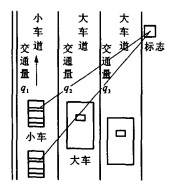-
摘要: 为了提高多车道高速公路内侧车道行驶的小车驾驶员视认路侧交通标志的准确率, 运用驾驶员的视认规律、车辆到达规律和概率计算方法, 建立了路侧交通标志遮挡问题的数学模型和算法。运用理论模型得出连续设置路侧交通标志的方法和步骤为: 决定标志设置位置, 计算遮挡矩形长度, 计算遮挡概率, 决定连续设置标志个数。计算结果表明: 设置1~6块标志时, 因遮挡驾驶员不能读取标志信息的概率为2.1×10-1~9.4×10-5, 不能读取标志信息的概率随连续设置标志的数量呈指数下降趋势, 建立连续设置路侧标志的模型和方法简便, 方案可行, 可以解决多车道高速公路路侧标志的遮挡问题。Abstract: In order to improve the accurateness that car driver recognizes roadside signs on the inboard driveway of more-lanes freeway, the mathematical model and algorithm to deal with the blocking problem of roadside traffic signs were set up by using driver visiblity disciplinarian, vehicle arrival disciplinarian and probability computation methods, the individual approaches and methods for setting roadside traffic signs in sequence were obtained by the theoretical model, they were how to determine the location of roadside signs, calculate the length of blocking rectangle, calculate the shelter probability and choose the number of roadside signs set in sequence. The simulation result shows that the blocking probability varies from 2.1 ×10-1 to 9.4×10-5 when the number of roadside signs set in sequence varies from 1 to 6, the blocking probability exponentially decreases with the number increase that of roadside signs, which indicates that the established models and methods to set roadside traffic signs in sequence are feasible, it can solve the blocking problem of roadside traffic signs on freeway with more lanes. 2 tabs, 7 figs, 10 refs.
-
Key words:
- traffic planning /
- freeway /
- traffic signs /
- mathematical model /
- highway capacity /
- safety device /
- signs blocking
-
表 1 车型参数
Table 1. Vehicle parameters
设计车型 长/m 宽/m 高/m 轴距/m 小车 4.7 1.7 2.0 2.7 货车 12.0 2.5 3.8 6.5 拖挂 16.5 2.5 3.8 4.0+9.0 表 2 车型换算系敛
Table 2. Equivalent coefficients of vehicle types
车型 小车 大车 车辆换算系数 1.0 2.0 -
[1] 杨久龄, 刘会学. 道路交通标志和标线——GB 5768—1999应用指南[M]. 北京: 中国标准出版社, 1999 [2] GB 5768-1999, 道路交通标志和标线[S]. [3] 刘浩学. 公路交叉口交通标志设置的工效学分析[J]. 交通运输工程学报, 2001, 1(3): 100-103. http://transport.chd.edu.cn/article/id/200103025Liu Hao-xue. Ergonomics of intersection traffic signal installation[J]. Journal of Traffic and Transportation Engineering, 2001, 1(3): 100-103. (in Chinese) http://transport.chd.edu.cn/article/id/200103025 [4] 王跃辉, 彭国雄. 指路标志设置位置的研究[J]. 道路交通与安全, 2004, 4(1): 26-31. https://www.cnki.com.cn/Article/CJFDTOTAL-DLJA200401007.htmWang Yue-hui, Peng Guo-xiong. Study about infornation sign location[J]. Road Traffic and Safty, 2004, 4(1): 26-31. (in Chinese) https://www.cnki.com.cn/Article/CJFDTOTAL-DLJA200401007.htm [5] 刘会学. 高速公路网络环境下交通标志的设计[J]. 公路, 2004, 48(12): 142-144. https://www.cnki.com.cn/Article/CJFDTOTAL-GLGL200412040.htmLiu Hui-xue. Traffic sign design under circumstances of expressway network[J]. Highway, 2004, 48(12): 142-144. (in Chinese) https://www.cnki.com.cn/Article/CJFDTOTAL-GLGL200412040.htm [6] 李文权, 王莉, 王炜. 高速公路上匝道合流区通行能力经验模型[J]. 交通运输工程学报, 2004, 4(2): 80-84. http://transport.chd.edu.cn/article/id/200402019Li Wen-quan, Wang Li, Wang wei. Empirical highway capacity model of on-ramp junction[J]. Journal of Traffic and Transportation Engineering, 2004, 4(2): 80-84. (in Chinese) http://transport.chd.edu.cn/article/id/200402019 [7] 李文权, 王炜. 交通事故时问分布规律[J]. 中国安全科学学报, 2005, 15(4): 56-61.Li Wen-quan, Wang Wei. Time distribution of traffic accident [J]. China Safety Science Journal, 2005, 15(4): 56-61. (in Chinese) [8] 郑安文, 牛倬民. 高速公路静态交通标志设置科学性分析[J]. 交通运输工程学报, 2002, 2(4): 49-53. http://transport.chd.edu.cn/article/id/200204011Zheng An-wen, Niu Zhuo-min. Scientific installation of static traffic signs on expressway[J]. Journal of Traffic and Transportation Engineering, 2002, 2(4): 49-53. (in Chinese) http://transport.chd.edu.cn/article/id/200204011 [9] 肖润谋, 赵金龙, 陈荫三, 等. 山区公路交通安全标志设计[J]. 长安大学学报: 自然科学版, 2006, 26(3): 63-67. https://www.cnki.com.cn/Article/CJFDTOTAL-XAGL200603015.htmXiao Run-mou, Zhao Jin-long, Chen Yin-san, et al. Design of traffic safety signs onmountain roads[J]. Journal of Chang'an University: Natural Science Edition, 2006, 26(3): 63-67. (in chinese) https://www.cnki.com.cn/Article/CJFDTOTAL-XAGL200603015.htm [10] 崔微. 道路交通安全设施设计的原理和方法[D]. 南京: 东南大学, 2004. -





 下载:
下载:







